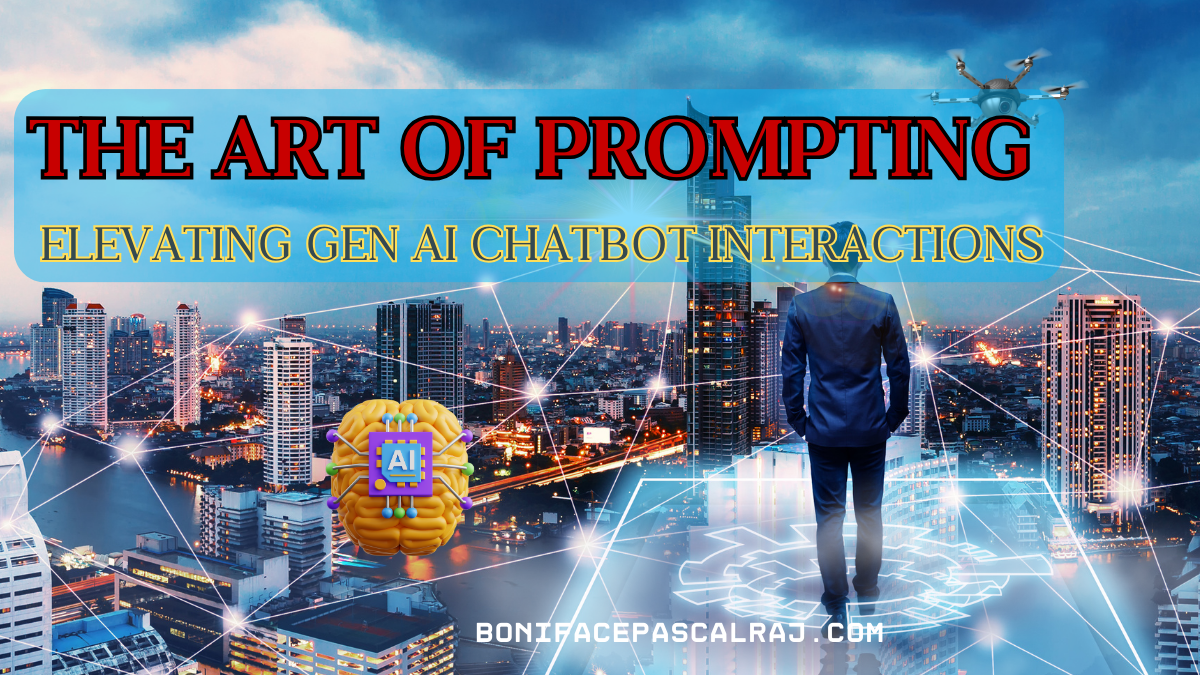In the field of Generative artificial intelligence (Gen AI), chatbot technology has gained significant traction over the years. These virtual assistants, powered by sophisticated algorithms and machine learning, are revolutionizing the way businesses and individuals communicate. Prompting is a crucial technique for achieving optimal results when using Generative AI chatbots. To ensure the desired outcomes, careful consideration must be given to how prompts are crafted and utilized. By employing strategic and well-thought-out prompts, businesses and individuals can enhance the overall effectiveness of their Gen AI chatbot interactions, thereby maximizing customer satisfaction and engagement. In this article, we will explore various strategies and methodologies for prompting Gen AI chatbots to maximize their potential and deliver a seamless user experience.
Prompting Styles: The style of prompting plays a crucial role in engaging users and maintaining their interest. Whether it’s authoritative, persuasive, formal, or conversational, the choice of style needs to align with the target audience and the purpose of the chatbot.
Here, we will see different prompt examples to get the crucial success factors for startups in various prompting styles.
Prompt 1: Authoritative Style
User Prompt: “List the key success factors for startups in the modern business landscape.”
Prompt 2: Persuasive Style
User Prompt: “Discover why knowing the key success factors for startups in today’s business world is your secret to unlocking prosperity.”
Prompt 3: Formal Style
User Prompt: “Kindly provide a structured enumeration of the essential success factors for startups within the contemporary business landscape.”
Prompting Style: Conversational Style
User Prompt: “Let’s chat about the factors that make startups thrive in today’s business world. What are they?”
Here, the choice of prompting style is a pivotal factor in engaging users and sustaining their interest when interacting with chatbots. The success of Gen AI chatbot interactions and the effectiveness of communication heavily rely on the careful consideration and application of the appropriate prompting style to achieve the desired engagement and outcomes.
Context and Content Style: To enhance the effectiveness of chatbot prompts, providing the right context is crucial. At times, providing additional context is essential to getting the desired results. Moreover, the Content Style used in the prompts can have a significant impact on user engagement and results.
Next, we will analyze a representative example for illustrative purposes.
User Prompt: “I am in the process of preparing a speech centered on the critical elements driving success for startups. This speech is intended for an audience of early-stage startup founders, and it will be delivered during a prominent national-level conference. For this speech, the style of content I’m aiming for is distinctly professional. I intend to employ vivid and expressive language to capture the multifaceted social realities within the entrepreneurial landscape. Given this context and content style, I kindly request your guidance on the key focal points that I should include and emphasize in my upcoming address.”
Here, the user’s prompt underscores the significance of context and content style in both Gen AI chatbot prompts and speech preparation. It stresses that ensuring the appropriate context and selecting the right content style are essential for effective communication. In certain situations, the inclusion of additional context becomes imperative to attain the desired results. Moreover, these factors can exert a substantial influence on user engagement and the overall effectiveness of communication.
Negative Prompt and Instructions: Sometimes, prompting a chatbot with negative statements can help explore unexpected solutions or challenge assumptions. Additionally, clear instructions provided to the chatbot can guide its responses and help users navigate through complex scenarios effectively. The negative prompts can be to explore solutions, challenge assumptions, spark creativity, or get step-by-step guidance on a complex scenario.
A range of negative prompts can be used to fulfill various purposes, such as delving into potential solutions, questioning assumptions, igniting creativity, or obtaining detailed guidance for intricate scenarios.
The examples presented below offer a precise representation of the aforementioned scenarios.
Prompt 1: Negative Statement to Explore Solutions
User Prompt: “Contradict common wisdom and explain why launching a startup without a business plan could lead to success.”
This prompt challenges the conventional notion that a business plan is essential for startup success. It encourages the chatbot to explore unconventional ideas and unexpected solutions.
Prompt 2: Negative Statement to Challenge Assumptions
User Prompt: “Challenge the assumption that competition is always detrimental to a startup’s growth and explain how healthy competition can be advantageous.”
This prompt prompts the chatbot to challenge the assumption that competition is entirely negative. It encourages the chatbot to provide insights into the benefits of healthy competition.
Prompt 3: Clear Instructions for a Complex Scenario
User Prompt: “Provide a step-by-step guide on how to handle a situation where a startup founder faces a major ethical dilemma, ensuring ethical principles are upheld throughout the process.”
This prompt gives clear instructions to the chatbot on how to guide users through a complex scenario involving an ethical dilemma. It ensures that the chatbot’s responses are precise and helpful in navigating such situations.
Prompt 4: Negative Statement to Spark Creativity
User Prompt: “Challenge the idea that failure is always negative for startups and discuss how learning from failure can lead to long-term success.”
This prompt encourages the Gen AI chatbot to challenge the negative perception of failure and highlight its potential for growth and success, sparking creativity in the responses.
These prompt examples demonstrate how negative statements and clear instructions can be used to engage a chatbot in exploring unconventional ideas, challenging assumptions, providing guidance in complex scenarios, and sparking creative discussions.

Seed Words and Background Information: Gen AI chatbot prompts can be enhanced by incorporating seed words and background information. These elements can spark creativity and give the chatbot a better understanding of the user’s requirements, resulting in more accurate and relevant responses. This can be used to include certain keywords, get responses based on certain background data, or combine certain keywords and background information.
This technique can be utilized to incorporate specific keywords, generate responses based on relevant background data, or merge specific keywords with contextual information.
In the following examples provided below, you will find illustrations that clarify the concept described above.
Prompt 1: Seed Words
User Prompt: “Using the seed words ‘sustainability’ and ‘technology,’ explain how startups can leverage innovation to drive sustainability in the modern business landscape.”
In this prompt, the inclusion of the seed words ‘sustainability’ and ‘technology’ provides specific focus areas. It guides the chatbot to generate responses that emphasize the connection between innovation, technology, and sustainability in startups.
Prompt 2: Background Information
User Prompt: “Given the background that the user is a solar energy enthusiast, provide insights into the latest advancements in solar panel technology and how they contribute to renewable energy sustainability.”
By providing background information about the user’s interest in solar energy, the chatbot can tailor its response to offer in-depth and relevant information about solar panel advancements, aligning with the user’s preferences and knowledge level.
Prompt 3: Combined Seed Words and Background Information:
User Prompt: “Considering the user’s role as a senior manager in a startup incubation program and using the seed words ‘mentoring’ and ‘innovation,’ explain the significance of mentorship in fostering innovation among startups.”
This prompt combines the seed words ‘mentoring’ and ‘innovation’ with the user’s background information as a senior manager in a startup incubation program. It guides the chatbot to provide insights specifically related to mentorship’s role in promoting innovation, aligning with the user’s professional context.
By incorporating seed words and background information in user prompts, chatbots can generate responses that are not only more accurate and relevant but also tailored to the user’s specific interests, needs, and context, thereby enhancing the overall conversational experience.
Templates and Target Audience: Using predefined templates can streamline chatbot prompting and ensure consistency in responses. Understanding the target audience is also crucial, as it allows the chatbot to tailor its prompts to match the expectations and preferences of the users. This technique can be utilized to acquire standardized templates and strategies for specific target audiences.
Prompt 1: Templates
User Prompt: “As a startup mentor, I need guidance on marketing strategies for tech startups in the healthcare industry.”
In this prompt, the user’s role as a startup mentor and the industry (healthcare) act as predefined templates. These templates guide the chatbot to generate responses tailored to the user’s specific role and industry, ensuring relevance and consistency.
Prompt 2: Target Audience
User Prompt: “Provide insights on social media advertising for a tech-savvy, young adult audience interested in gaming and technology.”
This prompt specifies the target audience as “tech-savvy, young adults interested in gaming and technology.” The chatbot can use this information to craft prompts and responses that align with the preferences and expectations of this specific audience, enhancing the user experience.
Prompt 3: Templates and Target Audience Combined
User Prompt: “As a marketing manager in the fashion industry, I need tips on engaging a youthful audience through Instagram.”
This prompt combines a predefined template (marketing manager in the fashion industry) with details about the target audience (youthful audience) and platform (Instagram). It enables the chatbot to provide guidance that suits both the user’s role and the characteristics of the audience and platform.
By using templates and understanding the target audience, Gen AI chatbots can offer more efficient and user-centric interactions. Templates ensure consistency, while knowledge of the target audience allows chatbots to tailor responses to user preferences and needs effectively.
Multiplier and Persona: Implementing multipliers in chatbot prompts can help generate more varied and creative responses. Additionally, developing a persona for the chatbot can enhance user engagement, making the interaction more personal and relatable.
Below are examples of prompt techniques such as multiplier and persona prompts. These techniques are designed to improve user comprehension and promote further exploration.
Prompt 1: Multiplier for Report Generation
User Prompt: “With the given data, generate ten different versions of the quarterly sales report.”
In this prompt, the user explicitly requests multiple versions (10) of the same content, which is the quarterly sales report. This demonstrates the use of a multiplier to generate multiple variations of the report, which can be helpful for analysis or comparison.
Prompt 2: Multiplier for Marketing Campaign Ideas targeting a Persona
User Prompt: “Provide five unique marketing campaign ideas for our new product launch, which is a low-carb, high-protein diet aimed at fitness freaks aged between 30 – 45 years.”
This prompt applies a multiplier by asking for five distinct marketing campaign ideas for a specific context—the new product launch aimed at a specific persona. The Gen AI chatbot can generate a variety of creative campaign concepts to explore.
Prompt Example 3: Multiplier for Blog Post Titles
User Prompt: “Give me ten catchy blog post titles for our travel blog.”
Here, the user requests ten different blog post titles, showcasing the multiplier concept. By specifying the number (ten) and the context (travel blog), the chatbot can generate a range of engaging and diverse blog post titles.
These prompt examples highlight how the use of multipliers in requests can lead to the generation of multiple versions or variations of the desired content, catering to specific needs and objectives.
Goals, Length, and Steps: Setting clear goals for the Gen AI chatbot and defining the desired length of the conversation can drive more focused prompts. Breaking down complex tasks into smaller steps can also help the chatbot guide users through comprehensive processes effectively.
Here are prompt examples to illustrate the techniques of setting clear goals, defining conversation length, and breaking down complex tasks into steps:
Prompt 1: Goals-Based
User Prompt: “Please provide a concise summary of the key features of the latest iPhone model, including its camera capabilities and price range.”
In this example, the goal is to obtain specific information about the latest iPhone model, focusing on features, camera capabilities, and price. The chatbot’s response should align with this goal, delivering a focused and informative reply.
Prompt 2: Length-Based
User Prompt: “I need a brief overview of the history of artificial intelligence. Please keep the response under 200 words.”
By specifying the desired length of the response (under 200 words), the chatbot is guided to provide a concise and to-the-point overview of the topic. This ensures that the conversation remains within the desired length.
Prompt 3: Steps-Based
User Prompt: “Hey, can you guide me through the process of setting up a personal budget? Start with creating categories for expenses.”
In this prompt, the user is seeking guidance on a complex task—setting up a personal budget. By breaking down the process into steps, the chatbot can provide sequential instructions, starting with the initial step of creating expense categories. This approach helps users follow the process systematically.
These prompt examples demonstrate how setting clear goals, defining conversation length, and breaking down complex tasks into steps can result in more focused and effective interactions with a Gen AI chatbot.
Examples and Follow-Up Prompts: Providing examples and follow-up prompts to the chatbot can facilitate learning and help users gain a better understanding of the topic at hand. These prompts can encourage users to explore further and yield more insightful conversations.
Here are prompt examples to illustrate the techniques of providing examples and follow-up prompts to enhance user understanding and encourage exploration:
Prompt 1: Examples-Based
User Prompt: “Hi, can you explain the concept of renewable energy sources? For instance, provide examples of commonly used renewable energy sources.”
In this prompt, the user requests an explanation of renewable energy sources with a specific request for examples. The chatbot’s response should include clear explanations of renewable energy sources along with real-world examples like solar power and wind energy.
Prompt 2: Follow-Up Prompts
User Prompt: “Hello, tell me more about solar power as a renewable energy source. How does it work, and what are its advantages?”
Here, the user initiates a follow-up prompt to dive deeper into a specific topic (solar power). The chatbot should provide an in-depth explanation, detailing how solar power works and highlighting its advantages.
Prompt 2: Encouraging Exploration
User Prompt: “Hi assistant, I’m interested in sustainable transportation. Can you provide an overview and suggest areas where sustainable practices can be implemented?”
In this prompt, the user expresses interest in a broad topic (sustainable transportation) and invites the chatbot to provide an overview while suggesting areas for exploration. The chatbot can respond with an informative overview and encourage the user to explore specific aspects of sustainable transportation.
These prompt examples demonstrate how providing examples and follow-up prompts can enrich user interactions with a Gen AI chatbot, fostering a better understanding of topics and encouraging users to explore further for more insightful conversations.
Role-based Prompts: When interacting with the Gen AI chatbot, asking it to assume a particular role can greatly enhance the user experience. By assigning a specific role to the chatbot, users can communicate their expectations more effectively, resulting in tailored and customized responses. This feature allows the AI tool to comprehend the user’s needs, concerns, and preferences more accurately, ensuring that the prompts are responded to in a way that aligns with the desired role. For example, if the user asks the chatbot to assume the role of a salesperson, the chatbot will emphasize providing product information, making recommendations, and offering promotional deals. On the other hand, if the user instructs the chatbot to be a customer service representative, it will prioritize addressing concerns, retrieving order information, and offering assistance with any issues. By allowing users to specify a role, the Gen AI chatbot can effectively adapt its responses and engagement style, ultimately providing a more satisfactory and enriching user experience.
Here are some examples to explain the role-based prompts.
Prompt 1: Tech Support Role
User Prompt: “Assume the role of a tech support expert. Help me troubleshoot my internet connection issue.”
Prompt 2: Tour Guide Role
User Prompt: “Imagine you’re a tour guide in Paris. Share interesting facts and must-visit places.”
Prompt 3: Recipe Creator Role
User Prompt: “Become a chef specializing in Italian cuisine. Share a delicious pasta recipe.”
A few more examples include Personal Assistant role, Language Teacher Role, Financial Advisor Role, Financial Advisor Role, Historical Figure Role, Travel Planner Role, Fitness Trainer Role, Fictional Character Role, and so on.
These examples demonstrate how assigning specific roles to the Gen AI chatbot can lead to tailored responses that align with the user’s expectations, whether it’s seeking advice, information, or engaging in creative scenarios. Role-based prompts allow users to have more personalized and interactive interactions with the chatbot, enhancing their overall experience.
Moreover, it is important to choose the right tone for the Gen AI chatbot prompts. Whether it’s educational, formal, conversational, or even playful, the tone must align with the desired impression and user experience. The different techniques can be combined together based on the needs to get the desired output.
In conclusion, the skill of creating successful Gen AI chatbot prompts is crucial in the field of Enterprise Technology. By understanding the importance of elements such as style, context, budget, instructions, and seed words, businesses and individuals can strategically utilize AI chatbots to enhance communication and improve operational efficiency. With ongoing advancements in AI technology, the future of chatbot prompting holds immense potential to revolutionize virtual assistant interaction in the realm of Enterprise Tech.




